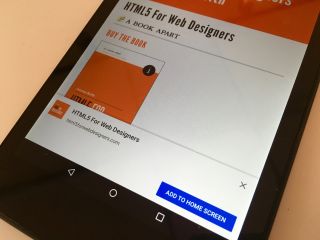I updated my Mac to the newest operating system, Sonoma. I did this to try out the new “add to Dock” feature in Safari. It’s like the “add to Homescreen” action on iOS.
Before I get into what’s good, I have to start by ranting about a big problem on both desktop and mobile: discovery.
First of all, you have to know that a square with an arrow sticking out of it means “share”.
Okay, I can buy it. It’s no better or worse than the three horizontal lines of a hamburger icon, or the three horizontal dots of a kebab icon. And whereas the hamburger and kebab icons are used as a catch-all cupboard to sweep all your rubbish into, at least this icon has a specific meaning. It means share, right?
Well, it used to. But now it’s also home to “add to Homescreen” and “add to Dock”. Neither of those actions are sharing.
Stretching semantics, I suppose you could say you’re sharing something with yourself.
Anyway, this is the biggest issue with progressive web apps on both iOS and Mac. Regardless of how well they work, there’s not much point if most people don’t know the option exists.
(Update: Jen rightly points out that you can also get to “add to Dock” from the file menu. Doh! How did I miss that‽)
Discovery aside, I was interested to see how Safari handles web apps on desktop compared to how Chrome does it.
I’ve had one or two web apps in my dock for a while, installed through Chrome. Google Meet is one of them. I use it quite a bit, and honestly it feels no different to using a native desktop app.
One annoyance is that the Chrome browser also automatically launches whenever I launch the Google Meet icon in my dock. This wouldn’t matter if Chrome were my default browser, but I use Firefox. So whenever I’m using the Google Meet web app, there’s a Google Chrome icon hanging around in my dock, saying “gizza job, I can do that.”
I opened Google Meet in Safari and then selected “add to Dock” from the square with an arrow sticking out of it. Then I quit Safari. I was delighted to see that when I launched the Google Meet web app from the dock, it didn’t automatically launch Safari! Excellent!
Even better, links within a Safari-installed web app respect your default browser choice. What I mean is, previously when I had Google Meet installed via Chrome, if I clicked an external link in Google Meet it opened in Chrome. But now with the Google Meet installed via Safari, external links open in Firefox, my browser of choice. Very good!
But the Safari-installed version of Google Meet is, alas, over-zealous with permissions. I have to grant access to my microphone and camera every single time I launch it. Previously—with the version installed via Chrome—it remembered my choice.
Now I don’t know if the behaviour in the Safari-installed version is a deliberate choice made for security reasons, or if it’s a bug. I suspect it’s a bug. After all, on iOS you get access to more permissions if a site is added to the homescreen—it’s the only way to ask for permissions for notifications, for example.
I added a few more sites to my dock: mastodon.social and thesession.org. They both work really well as standalone apps.
Interestingly, if I click a link to thesession.org from within the mastodon.social standalone web app (or the other way around), the link opens in my default browser. So the web apps don’t “own” the domains. That’s fine, although I wonder if it violates the principle of least surprise—perhaps the expectation is that the installed web app is the preffered owner of that link.
I also tried adding Google Calendar to my dock. Ironically, I can only do this with Safari. For some reason, Google have chosen not to make their calendar a progressive web app …which means there’s no option to install it from Google Chrome.
They’re missing a trick there. It’s the perfect candidate for being a standalone app.
Actually, I take that back. Gmail is the perfect candidate for being a standalone app …and yet it’s not a progressive web app. Very odd!
With Safari, you can add any website to the dock. It doesn’t need to be a progressive web app. But the installation experience works best if there’s a manifest file pointing to some nice icons.
As it turned out, Google Calendar runs like an absolute dog in Safari (and therefore as a Safari-installed web app). Before you cry conspiracy, note that it runs absolutely fine in Firefox. I know because I use it in Firefox every day. But I can’t add it to my dock from Firefox because Mozilla turned their back on progressive web apps a while back. A bad decision.
Google Calendar isn’t the only thing that runs slowly in Safari’s engine. This page on The Session has a very large DOM and a badly-coded in-page search (I know, I know, I need to improve it). It works fine in other browsers but Safari struggles mightily.
(Update: I tried using Google Calendar from Safari again and it seems to be running just fine now. Maybe I caught it on a bad day? In any case, I’ve added it to the dock now and it’s feeling good as a standalone app.)
Still, aside from a few annoying little things around permissions and performance—and the situation with discovery—it feels great to have websites that act just like other apps. I like that some of the icons in my dock are native, some are web apps, and I mostly don’t notice the difference.
I wonder if there’s much point using wrappers like Electron any more? I feel like they were mostly aiming to get that parity with native apps in having a standalone application launched from the dock.
Now all you need is a website.





